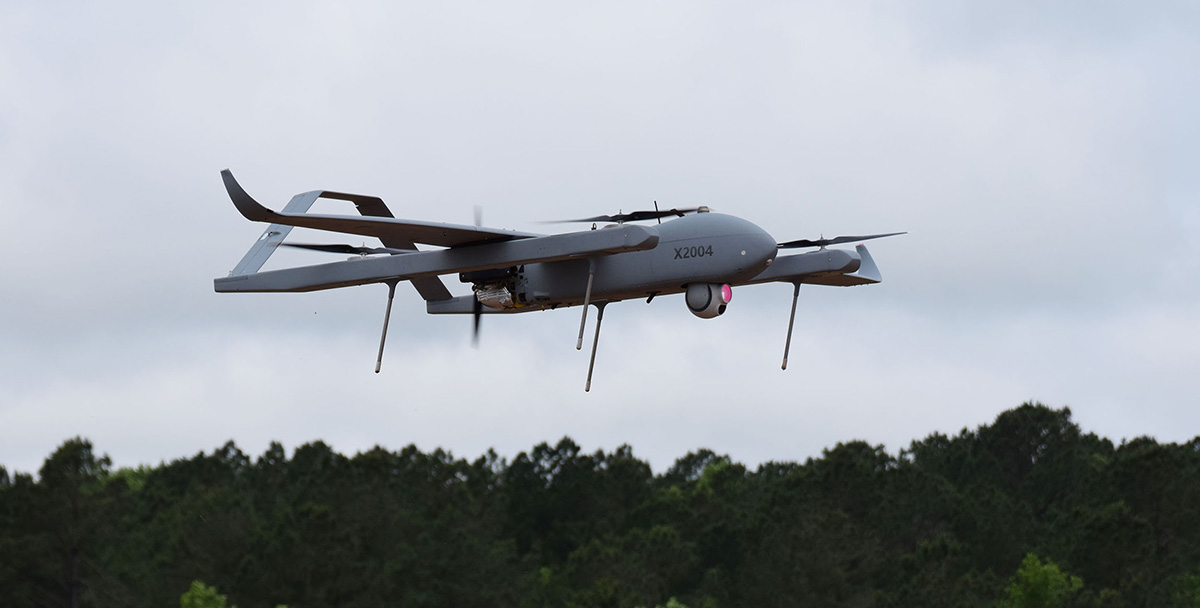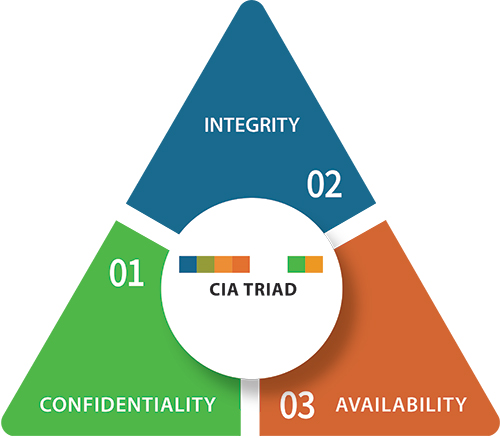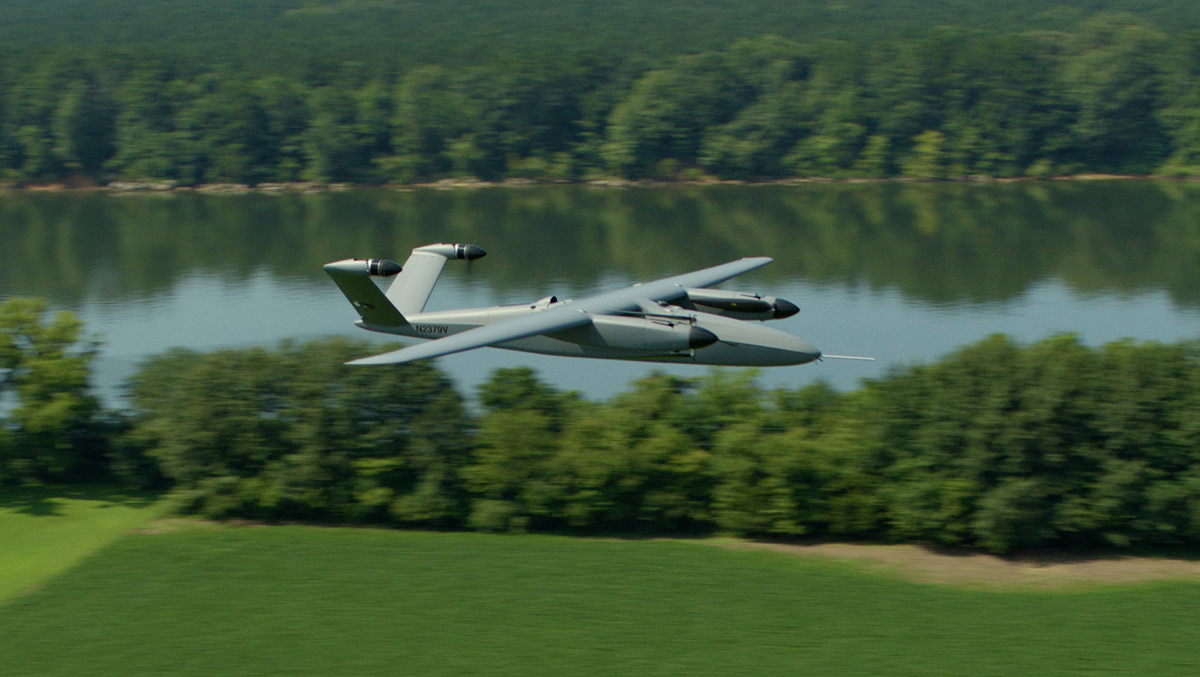Unmanned Aircraft Systems
Information Security Threats Within the Cyber Domain
By Company F, 227th Aviation Regiment, "Godfathers" Fort Cavazos, Texas
Article published on: October 1, 2024 in the Aviation Digest October-December 2024 Issue
Read Time: < 6 mins

The Aerosonde® Mk. 4.8 Hybrid Quad UAS at Redstone Arsenal, Alabama. Courtesy photo: Program
Executive Office, Aviation.
Information security (INFOSEC) applies to all information, regardless of its domain. Technological advancements
challenge the security of information, especially within the cyber battlefield. Security considerations must be
applied based on the protected data’s value. Information that should be secured may include proprietary rights,
information sent across networks, or system accessibility. The three fundamental tenets of INFOSEC are
confidentiality, integrity,and availability (Figure) (LBMC, 2022). Threat nations, especially pacing threats
such as China or Iran, will aggravate those security measures to leverage strategic advantage. Since unmanned
aircraft systems (UAS) operate exclusively within the cyber domain through network communication, it is
imperative to understand the capabilities threatening UAS INFOSEC.
“The Advanced Encryption Standard (AES) is a symmetric block cipher chosen by the U.S. government [2001] to
protect classified information”
(Awati et al., n.d.).
Confidentiality of information pertains to the measures emplaced to permit only authorized
users access during storage or operational use. Additionally, confidentiality does not include attacks that
intend to alter or modify. Exploits to breach confidentiality protocols may include methods that attempt to
receive or access information through unauthorized methods. Security protocols that emphasize physical
components are the most widely used for retaining confidentiality. “The universal technique for providing
confidentiality for transmitted or stored data is symmetric encryption” (Stallings & Brown, 2015, p. 41). Threat
actors may breach the confidentiality of information in a variety of schemes. For simplicity and applicability
purposes, focusing on threats that take advantage of network infiltration is paramount.

Figure. The three fundamental tenets of INFOSEC. “Together, they are called the CIA
Triad” (LBMC, 2022). Triad drawing courtesy of LBMC.
Bharat B. Madan, Manoj Banik, and Doina Bein, Department of Modeling, Simulation, & Visualization Engineering
professors at Old Dominion University, USA, express concerns with information confidentiality stating, “An
attacker can also compromise the confidentiality of an [sic] UAS by capturing data communicated over network
links” (Madan et al., 2016, p. 6). A threat actor may extract transmitted data packets by acquiring access to
the network. The system acquisition may be accomplished through brute force hacking the encryption system or
using social engineering methods. Conversely, brute force hacking is infrequent due to the sophistication of the
embedded Advanced Encryption Standard.
The Data Encryption Standard is a symmetric block cipher adopted in 1977 by the National Institute of
Standards and Technology. The AES “is intended to replace DES and DES with an algorithm that is more secure and
efficient” (Stallings & Brown, 2015, p. 645).
An additional attack process may entail exploiting human negligence through social engineering (Stallings &
Brown, 2015). Phishing e-mails, physical tailgating, or deceptive interviews are all used to retrieve
information that can be utilized to gain unauthorized access. Afterward, attackers may install malware to
manipulate protocols to create a bypass directed into the system (Madan et al., 2016).
The Data Encryption Standard andAdvanced Encryption Standard are two critical principles that fortify symmetric
encryption (Stallings & Brown, 2015, pp. 643-645). These standards utilize block ciphers, which are
fundamentally a password-based authentication. However, security protocols are generally irreversible by
end-users without authorization from a privileged user. As such, all Soldiers, Department of Defense (DoD)
contractors, and DoD Civilians are the first line of enforcement when protecting information. Army Regulation
25-2, “Army Cybersecurity,” establishes policies for securing data from unauthorized users (Department of the
Army, 2019). First, the enforcement of physical security will deter unwanted threats. Secondly, users must
comply with the appropriate handling or storing procedures dependent on the information classification. Lastly,
end-users should spread awareness of cybersecurity threats and those measures used to prevent attacks.
The integrity of information involves the accuracy and validity of data during transmission. Security measures
used to protect the integrity of information share semblance to those in confidentiality. However, unlike
confidentiality, integrity encompasses modifying data or the origin of data provided to the user. The act of
altering data can be just as catastrophic as having no data at all. Since viable strategies derive from unerring
information, an attack on integrity may lead to poor decisions and judgment. Protecting information integrity
ensures that the information retains its authenticity for accurate and timely decisions. In our opinion and
combat experience, one of the biggest threats to information integrity of UAS operations is Global Positioning
Systems (GPS) spoofing through modification or masquerading.
Global Positioning System spoofing is employed to tamper with the integrity of GPS information. Generally, GPS
spoofing transmits broad-ranging signals to deceive GPS receivers within proximity. These transmissions then
cause the receivers to display arbitrary locations. However, a new technology developed in China allows GPS
spoofing to be used in a calculated method to alter GPS locations into a fixed pattern. The technology, which
enables spoofers to deploy GPS attacks deliberately, was inconceivable until now. Todd Humphreys, the head of
Radionavigation Laboratory at the University of Texas, states, “To be able to spoof multiple ships
simultaneously into a circle is extraordinary technology” (Trevithick, 2019). Global Positioning System
spoofing, now coupled with new technology, is a developing threat that sends UAS operations into disarray.
Accurate GPS information is critical in mission planning and execution; therefore, it requires security measures
to ensure validity. Successful spoofing entails three components: a transmitter, frequency, and a receiver
(McAfee,™ 2020). Identifying the weakness in those components will aid in avoiding deception. The transmitter
and frequency are threats based on their locality, and as such, may be avoided through evasive procedures. If
those threats are unavoidable, the receiver is now an active threat. Typically, receivers have embedded
anti-spoofing modules within their encryption systems (e.g., Selective Availability Anti-Spoofing Modules).
However, if those modules are compromised, maneuvering through “map to video” correlation is required. Security
measures focused on information integrity will help guarantee all information is valid for use in the
decision-making process.

The Valiant UAS at Redstone Arsenal, Alabama. Courtesy photo: Program Executive Office,
Aviation. .
Information availability consists of the user’s ability to perform actions when required. In
some cases, denying information availability may permit unauthorized users to breach confidentiality and
integrity. Since availability threats indicate a form of system denial, the same security measures designed for
the other tenets may not work. Additionally, common system protocols are embedded, and monitoring their
effectiveness may be restricted. A common way to combat an availability threat is to develop redundancies into a
system. These may include alternate ways to perform actions or a contingency plan to execute during denied
service. Unmanned aircraft system operations should be primarily concerned with Denial of Service (DoS) attacks
devised to deny communications or seize access and control of the aircraft.
Denial of Service1 attacks deploy
interferences through frequency overflow that overburden the bandwidth or resources (Stallings & Brown, 2015).
Denial of Service methods cited within Stallings’ & Brown’s book express direct concerns for UAS operations.
Furthermore, though it may not originate from DoS attacks, commandeering may be a form of availability denial
that is utilized. Threats against system unavailability were demonstrated during an incident that involved the
hijacking of an RQ-170 stealth drone by Iran in 2011. Iran cyber experts seized control over the aircraft and
used reverse engineering to gather proprietary schematics (Opall-Rome, 2018). This event revealed the
devastating cause and effects of an attack on system availability.
Military + Aerospace Electronics published an article that inferred the results of the RQ-170 incident
caused the Pentagon to advocate the need for higher levels of cybersecurity (Keller, 2016). Keller’s article
emphasizes how disastrous this attack was on cybersecurity and the Pentagon’s determination to make
cybersecurity a top priority. The necessity for securing availability presents several concerns. In terms of
technology, systems already have internal defense mechanisms to protect against attacks through wireless
assaults. However, the DoD emphasizes the importance of the human factor in cybersecurity by analyzing the
Navy’s nuclear-propulsion program designed by the “Father of the Nuclear Navy,” Admiral Hyman Rickover
(Winnefeld et al., 2015). The program’s cybersecurity process enforces the technical development of all users to
provide maximum results. As UAS experts, all users need to understand and apply security methods that the system
employs to protect information availability.
Information security is paramount for successful operations against pacing threats that dominate the cyber
domain. Decision-makers should consider the three tenets when performing operations or planning engagements.
Confidentiality of information must be established to ensure only authorized users have access to confidential
information. Information integrity is accomplished by allowing only authorized users to modify data. In our
experience, the foundation of information availability is preventing, identifying, and reacting to attacks that
may deny system access. However, this is easier said than done. The cyber domain is a vast and unpredictable
realm that is hemorrhaged by technological advancements. Human due diligence is essential if technologies were
ever to fail. Information security requires attention from all users to prevail against opposing forces.
Notes
1.“A denial-of-service condition is accomplished by
flooding the targeted host or network with traffic until the target cannot respond or simply crashes,
preventing access for legitimate users” (Cybersecurity & Infrastructure Security Agency, 2021).
References
Awati, R., Bernstein, C., & Cobb, M. (n.d.). Advanced encryption standard (AES). TechTarget. https://www.techtarget.com/searchsecurity/definition/Advanced-Encryption-Standard
Cybersecurity & Infrastructure Security Agency. (2021). Understanding denial-of-service attacks.
https://www.cisa.gov/news-events/news/understanding-denial-service-attacks
Department of the Army. (2019, May 4). Army cybersecurity (Army Regulation 25-2).
https://armypubs.army.mil/epubs/DR_pubs/DR_a/ARN37506-AR_25-2-003-WEB-4.pdf
Keller, J. (2016, May 3). Iran-U.S. RQ-170 incident has defense industry saying ‘never again’ to
unmanned vehicle hacking. Military + Aerospace Electronics.
https://www.militaryaerospace.com/computers/article/1675072/iranus-rq170-incident-has-deffense-industry-saying-never-again-to-unmanned-vehicle-hacking
LBMC. (2022, May 23). Three tenets of information security.
https://www.lbmc.com/blog/three-tenets-of-information-security/
Madan, B. B., Banik, M., & Bein, D. (2016, February 23). Securing unmanned autonomous systems from cyber
threats. The Journal of Defense Modeling and Simulation: Applications, Methodology, Technology,
16(2), 119-136.
https://doi.org/10.1177/1548512916628335
McAfee.™ (2020, August 25). What is GPS spoofing?
https://www.mcafee.com/blogs/consumer/what-is-gps-spoofing/
Opall-Rome, B. (2018, February 12). Israel Air Force says seized Iranian drone is a knockoff of US
Sentinel. Defense News.
https://www.defensenews.com/global/mideast-africa/2018/02/12/israel-air-force-says-seized-iranian-drone-is-a-knockoff-of-us-sentinel/
Stallings, W., & Brown, L. (2015). Computer security: Principles and practice (3rd ed.). Pearson
Education, Inc.
https://www.cs.unibo.it/~babaoglu/courses/security/resources/documents/Computer_Security_Principles_and_Practice_(3rd_Edition).pdf
Trevithick, J. (2019, November 19). New type Of GPS spoofing attack in China creates “crop circles” of
false location data. The War Zone.
https://www.twz.com/31092/new-type-of-gps-spoofing-attack-in-china-creates-crop-circles-of-false-location-data
Winnefeld, J. A., Jr., Kirchhoff, C., & Upton, D. M. (2015, September 09). Cybersecurity’s human factor:
Lessons from the Pentagon. Harvard Business Review, 86-95.
https://hbr.org/2015/09/cybersecuritys-human-factor-lessons-from-the-pentagon
Author
The F/227th is a UAS company assigned to the 1st Air Cavalry Brigade, 1st Cavalry Division, at Fort Cavazos,
Texas. The unit’s last combat deployment was to Al-Asad, Iraq, in October 2021—June 2022. For composition,
the F/227th is comprised of Six Platoons: Headquarters, Ground Vehicle Maintenance, Air Vehicle Maintenance,
and three Flight Platoons. There are two commissioned officers, 10 Warrant Officers, 43 noncommissioned
officers, and 72 Troopers, totaling 127 service members. The F/227th is currently deployed in support of
operation Atlantic Resolve in the European Command area of responsibility.